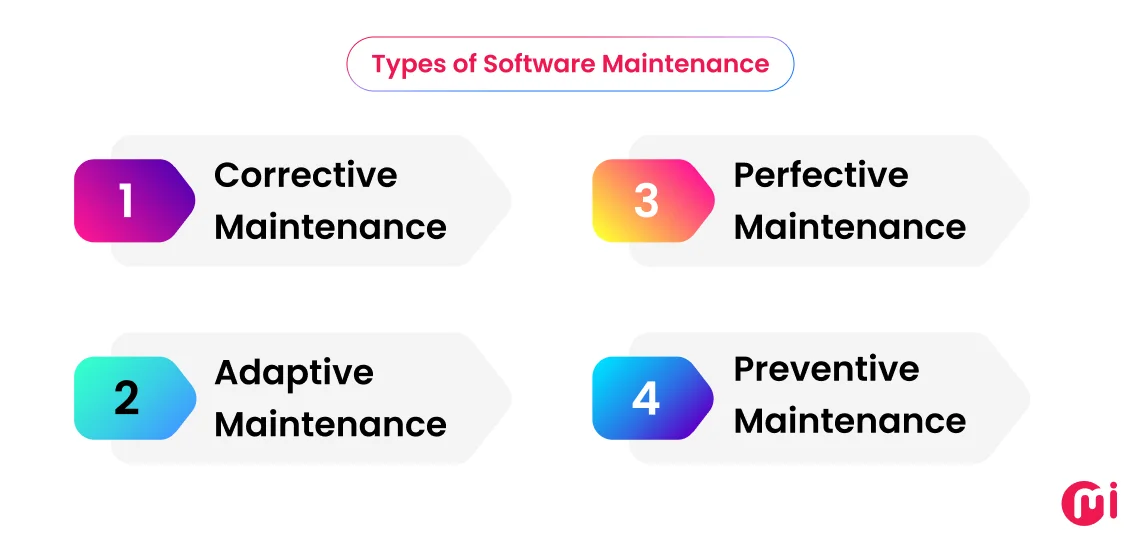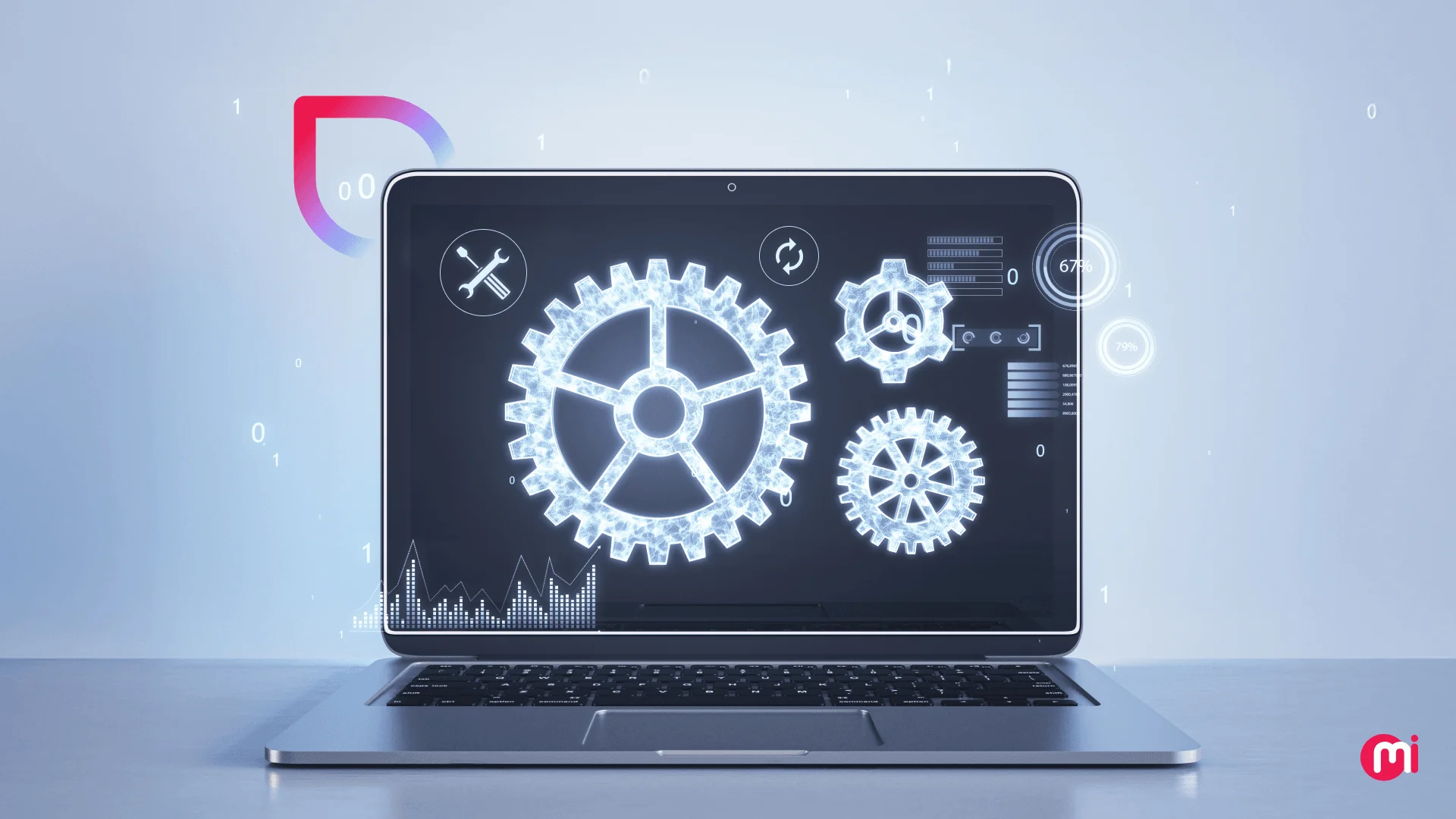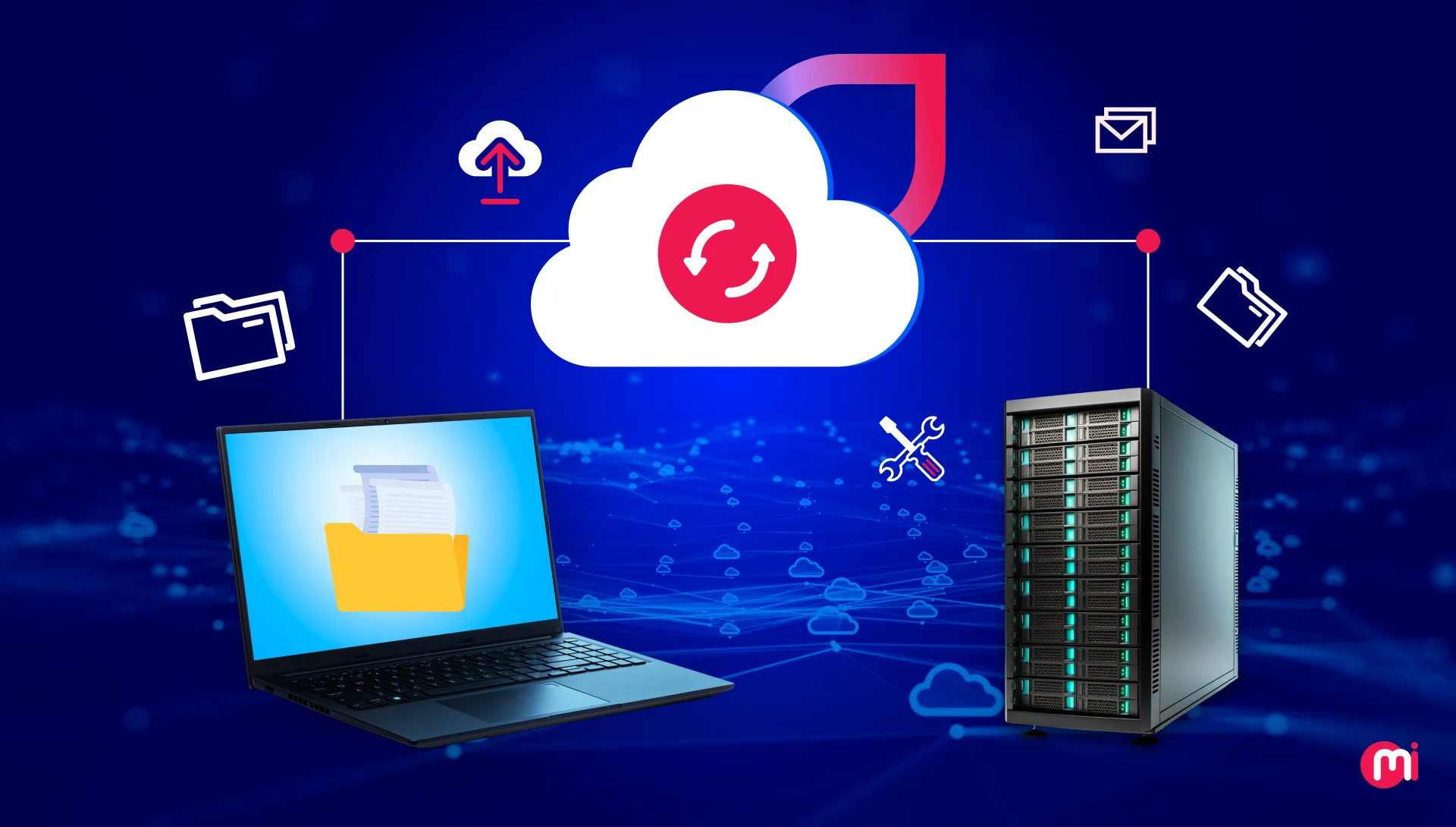Software Application Maintenance Guide: Benefits, Types, Process & Models Explained!
- Software
- June 5, 2025
Software maintenance plays a critical role in ensuring long-term application reliability, performance, and security. As user needs evolve and technology advances, maintaining software becomes essential to keep systems efficient, scalable, and aligned with business goals. This blog explores what is software maintenance? Why software application maintenance is indispensable, highlights its key types and models, addresses common challenges, and shares actionable strategies for sustaining high-quality software well beyond its initial deployment.
Software maintenance is a crucial phase of the Software Development Lifecycle (SDLC), ensuring that a system continues to perform optimally after deployment. Moreover, in this dynamic environment, user expectations, security standards, and technology ecosystems evolve constantly, making software maintenance more important.
In fact, software development statistics show a significant portion of IT budgets is now allocated to ongoing application maintenance and support. But what is software maintenance exactly? Is it just about fixing bugs and patching security holes? Or does it go deeper into refining performance, adapting to new platforms, enhancing user experience, and reducing technical debt?
This blog breaks down software application maintenance in its entirety, explores the types of software maintenance, processes, models, costs, benefits, and challenges, and explains why it’s not just a technical obligation but a business-critical strategy.

What is Software Maintenance?
Software maintenance is the process of updating and improving software after it has been released. It includes fixing bugs, adding new features, boosting performance, and making the software compatible with new hardware or operating systems. Far from being a one-time effort, software maintenance is an ongoing cycle that keeps applications efficient, competitive, and relevant in the long run. It ensures that the software remains reliable, secure, and aligned with evolving business needs and technological advancements.
What’s the Importance of Software Maintenance?
Software maintenance ensures consistent software performance, increases ROI, provides better security, adapts to changing user needs and technological advancements, enhances capabilities, reduces downtime, and supports project collaboration. Here are more insights into the importance of software maintenance and how they extend software lifespan.
1. Long-Term Product Performance
Regular maintenance ensures that software remains efficient, stable, and responsive over time. As user expectations grow and technology evolves, maintaining the product allows it to keep performing at its best without major rework. It helps in identifying and fixing hidden bugs, optimizing code, and updating systems for better performance.
2. Increased ROI
Proper software maintenance extends the life of the software, prevents the need for expensive redevelopment, and increases return on investment. It keeps the software aligned with current business processes, helps make changes in the existing software and follow ongoing software development trends. Effective maintenance minimizes disruptions, ensuring continued value from the initial software development cost.
3. Better Security and Scalability
Security threats evolve constantly, and maintenance ensures that software stays protected through timely updates and patches. In addition, as the user base grows or data load increases, scalability improvements through maintenance ensure that the software continues to perform smoothly without performance issues.
4. Capability Enhancement
Software maintenance allows for the addition of new features and functionalities while keeping the software up-to-date with market needs and user demands. It also enables businesses to stay competitive by continuously improving the product’s capabilities without starting from scratch.
5. Seamless Project Continuation and Collaboration
Maintained software is easier to understand, manage, and update, especially for teams that take over existing projects. Clean documentation, updated codebases, and structured updates ensure smoother collaboration among developers, making transitions easier and more efficient.
6. Reduced Downtime and Improved User Experience
Maintenance prevents unexpected system failures by proactively fixing issues and optimizing processes. It leads to fewer disruptions and a smoother experience for end-users, which in turn builds trust and satisfaction with the product.
7. Adapts New Technologies Easily
Regular maintenance makes integration with new platforms, tools, or devices easy and seamless. It ensures compatibility with modern technologies, operating systems, and frameworks, keeping the product relevant in a fast-changing tech environment.

What are the Main Types of Software Maintenance?
There are four main types of software maintenance, including corrective, adaptive, perfective, and preventive. Each type serves a different purpose to keep your application running efficiently and adapting to changing needs. Here is a detailed breakdown of each type and its impact:

1. Corrective Maintenance
Corrective maintenance is triggered after a problem is detected, either through user feedback, internal audits, or automated error logs. It’s reactive in nature and essential for ensuring software reliability. Corrective maintenance is required after a problem is detected, either through user feedback, internal audits, or automated error logs.
What Does It Involve?
- Fixing bugs reported by users
- Resolving system crashes or performance issues
- Correcting logic or coding errors
- Addressing flaws discovered during monitoring or testing
2. Adaptive Maintenance
Adaptive maintenance refers to the updates and changes made to software to ensure a smooth workflow when the environment around it changes. This includes changes in technology, rules, or business needs. It’s not about fixing bugs; it’s about making sure the software stays compatible and continues to perform well. Adaptive maintenance becomes necessary whenever something in the software’s external environment changes, like a server upgrade, a cloud migration, or a new data privacy law.
What Does It Involve?
- Modifying the software to work with new operating systems or hardware
- Updating integrations due to changes in external APIs or platforms
- Adjusting functionality to meet new legal or compliance standards
- Adapting features to align with changing business processes or goals
3. Perfective Maintenance
Perfective maintenance involves making improvements to software that is already functioning correctly. The goal is to enhance performance, increase efficiency, and meet changing user or business needs. It usually takes place after the software has been released, and it is based on feedback from users, performance data, or evolving requirements. This type of maintenance helps the software stay useful, relevant, and aligned with business goals.
What It Includes:
- Improving the user interface
- Enhancing system performance
- Adding new features
- Modifying existing functions for better usability
- Updating workflows or processes to match new business needs
4. Preventive Maintenance
Preventive maintenance identifies and fixes potential issues before they cause damage. The type of software maintenance improves long-term stability and performance. It reduces the risk of future failures and minimizes unexpected downtime. It involves code cleanup, performance optimization, and strengthening security.
What It Includes:
- Refactoring code to reduce technical debt
- Optimizing performance before it slows down
- Updating outdated components
- Strengthening security to prevent future breaches
- Improving documentation for an easier future maintenance
How Software Application Maintenance Works: A Process Overview
A structured software maintenance process involves identifying issues, analyzing them, designing solutions, implementing changes, testing, and deploying updates. This process is crucial for maintaining software functionality, improving performance, and adapting to changing environments. Without a well-defined approach, maintenance can become inefficient, leading to increased downtime, security risks, and user dissatisfaction.
Here is a detailed breakdown of software maintenance process phases:
Phase 1 – Request & Issue Identification
In this phase, tech teams identify software modification requests from users, monitoring tools, or internal audits. Each request is logged with an identification number for tracking.
Developers then classify the request based on the type of maintenance activity: corrective (fixing bugs), adaptive (responding to environment changes), preventive (avoiding future issues), or perfective (improving performance or usability). The team also evaluates and prioritizes each request to set the order of processing.
Phase 2 – Analysis & Feasibility Study
After identifying the request, the development team analyzes the issue to understand its cause and scope. They evaluate how the change will affect the system and determine if it’s technically and financially feasible. This includes checking for resource availability, required tools, and compatibility with existing infrastructure. Any potential risks or limitations are noted. The goal is to decide whether the request should move forward and, if so, how.
Phase 3 – Planning & Prioritization
After confirming feasibility, the team creates a detailed plan for implementing the change. They define the tasks, timelines, responsible developers, and any dependencies. Requests are reprioritized based on updated impact assessments and business needs. The team ensures high-impact assessments and business needs.
The team ensures that high-impact or urgent requests are addressed first. Clear planning helps manage workload, avoid conflicts, and set realistic expectations for delivery.
Phase 4 – Design and Impact Assessment
In this phase, the team prepares a technical design outlining the required changes. The design includes updates to existing features, bug fixes, or performance improvements. Experts conduct impact assessments to evaluate how these changes affect other parts of the system, including dependencies, integrations, and user experience. They review and consider risks, conflicts, and system stability and document the design updates before moving forward to implementation.
Phase 5 – Implementation and Coding
Developers make the necessary code changes according to the approved design. This includes updating the source code, configuration files, or scripts. All changes are committed to version control to maintain traceability. The team follows coding standards and ensures that any required documentation is updated. Internal reviews or peer checks may be performed to verify that the implementation meets quality standards.
Phase 6 – Testing and Validation
Once development is complete, the updated software is tested to confirm it functions as expected. The team runs unit tests, integration tests, and regression tests to ensure stability and correctness. If applicable, user acceptance testing (UAT) is conducted to get feedback from involved members. Any issues found during testing are documented, fixed, and retested. Testing ensures the change is safe to release.
Phase 7 – Deployment
After successful testing, the change is deployed to the production environment. The team follows the deployment procedures to minimize disruption, and a rollback plan is prepared in case of failure. Post-deployment, the system is monitored for performance or errors. Once confirmed stable, the request is marked as complete, and final documentation updates are made. Creators are notified, and lessons learned are noted for future maintenance work.

Common Challenges in Software Maintenance and Their Solutions
Software maintenance faces numerous challenges, including technical debt, dependency management, system complexity, security vulnerabilities, legacy systems, advanced technologies integration, and frequent change in requirements. Here’s a more detailed look at some common challenges and their solutions:
1. Technical Debt
Accumulated shortcuts or quick fixes make the codebase complex and messy over time. This slows down development, increases the risk of bugs, and raises long-term maintenance costs. To deal with the issue, regularly refactor code, enforce coding standards, and schedule time to address technical debt incrementally.
2. Dependency Management
Software often relies on third-party tools, APIs, or libraries that change independently. Poor management can cause compatibility issues, breaking integrations and delaying updates. Use dependency management tools, monitor updates, and test integrations during routine maintenance cycles to avoid the mismanagement.
3. System Complexity
Large and interconnected applications often have code dependencies that are hard to manage. Even small changes can cause unexpected bugs or system-wide issues. Hence, modularize the codebase, document interdependencies clearly, and apply impact analysis before implementing changes.
4. Security Vulnerabilities
Older software often lacks updated security measures, putting systems at risk if not regularly maintained. Without regular maintenance, it becomes vulnerable to breaches and compliance issues. Perform regular security audits, patch vulnerabilities promptly, and stay updated with compliance standards.
5. Legacy Systems
Older software may run on unsupported or outdated technologies. Maintaining them is costly and risky, often requiring legacy software modernization services or full replacement. Assess the system’s viability and gradually modernize or migrate to updated platforms with scalable architectures.
6. Advanced Technologies Integration
Incorporating cloud, automation, or AI in software development or during upgradation can make systems harder to maintain. Without proper expertise, these additions can create more complexity than value. Hire software developers with required expertise, use clear integration strategies, and evaluate ROI before adopting emerging technologies.
7. Frequent Change in Requirements
Frequent shifts in business goals or user expectations require software adjustments, making it hard to maintain consistency, leading to unstable or fragmented systems. Implement agile practices, maintain flexible architecture, and align development with evolving business priorities through proper change management.

How Much Does Software Maintenance Cost?
Each year, for software maintenance, you should set aside about 15% to 25% of your software development cost. However, the final software maintenance cost depends on various factors and unexpected issues, like security threats or compatibility problems, can increase costs over time.
Software Maintenance Cost Estimation By System Complexity
| System Complexity | Estimated Annual Cost |
| Low (Simple Software) | $1500-$5000+ |
| Medium (Standard Software) | $4000-$20000+ |
| High (Enterprise Level Software) | $10000-$50000+ |
Key Factors That Affect Software Maintenance Cost
- Software complexity
- Type of software
- High-end features, integrations, or legacy code
- Technology stack
- Type of required maintenance
- Frequency of updates
- Code quality
- Team structure
- Quality requirements
5 Widely Used Software Maintenance Models
Software maintenance models offer structured approaches to updating and improving software over its lifecycle. Different models suit different scenarios in which some are reactive, while others are proactive or evolution-focused. Selecting the right model, from quick-fix, interactive, reuse-oriented, Boehm’s, and Taute, depends on the nature of the application, its complexity, and long-term business goals.
Below are the details of software maintenance models, helping you make the right decision.
1. Quick-Fix Model
The Quick-Fix Model in software maintenance is an ad hoc approach that prioritizes rapid resolution of issues over comprehensive solutions. It’s primarily employed in emergencies where swift action is necessary to restore system functionality. This mode involves making immediate, localized changes to the codebase with minimal analysis of potential long-term impacts.
While the Quick-Fix Model offers the advantage of speed and low initial cost, it often leads to the accumulation of technical debt and degradation of the software’s overall structure. Therefore, it’s best suited for urgent fixes and should be followed by more thorough maintenance to ensure long-term software performance.
2. Iterative Enhancement Model
The Iterative Enhancement Model is a software maintenance approach that emphasizes continuous, incremental improvements to a system. Instead of implementing extensive changes all at once, this model advocates for making small, manageable updates in successive iterations.
Each iteration involves analyzing the current system, classifying the necessary modifications, and implementing those changes. This process allows for regular feedback and adjustments, ensuring the software evolves in alignment with user needs and technological advancements.
This model is particularly beneficial in dynamic environments where requirements frequently change. By breaking down the maintenance process into smaller tasks, it becomes easier to manage complexity and maintain a high-quality design.
3. Reuse-Oriented Model
The Reuse-Oriented Model in software maintenance emphasizes utilizing existing components to enhance or build new systems, thereby reducing development time and costs. This approach involves identifying suitable parts from the current system, modifying them to meet new requirements, and integrating them into the updated application.
It’s particularly effective when a repository of well-documented, reusable components is available. However, the model’s success heavily depends on the availability and compatibility of these components. In scenarios where suitable reusable parts are lacking, new components must be developed, potentially diminishing the efficiency gains.
4. Boehm’s Model
The Boehm’s Software Maintenance Model, introduced by Barry Boehm in 1983, applies economic principles to the software maintenance process. It emphasizes evaluating proposed changes through cost-benefit analysis to ensure that maintenance decisions are economically justified. The model is represented as a closed-loop cycle, where management decisions drive the process, balancing maintenance objectives against environmental constraints.
In this model, changes are first proposed and then assessed for their economic viability. Approved changes are implemented within the constraints of company budgets and resources. Boehm’s approach aids maintenance managers in making informed decisions that align with both technical requirements and economic considerations.
5. Taute Maintenance Model
The Taute Maintenance Model, introduced by B.J. Taute in 1983, offers a structured approach to software maintenance, emphasizing a cyclical process for implementing changes. This model is particularly suited for corrective maintenance, focusing on resolving issues post-deployment.
Key Phases of the Taute Maintenance Model:
- Change Request Phase: Users submit requests for modifications, categorized into corrective, adaptive, perfective, or preventive maintenance.
- Estimate Phase: The maintenance team assesses the time and resources required for the proposed changes.
- Schedule Phase: Change requests are prioritized and scheduled for implementation.
- Programming Phase: Developers modify the source code to implement the requested changes.
- Test Phase: The modified software undergoes testing to ensure the changes function as intended.
- Documentation Phase: System and user documentation are updated to reflect the changes.
- Release Phase: The updated software is delivered to the user for acceptance testing.
- Operation Phase: Post-acceptance, the software enters normal operation, with ongoing monitoring and support.
This model’s cyclical nature ensures continuous improvement and adaptation of the software, aligning with user needs and technological advancements.
Best Practices to Improve Software Application Maintenance
Improving software application maintenance requires a proactive and well-organized approach. From documentation to automation, each element plays a vital role in keeping your application stable, secure, and scalable. Below are key tips to enhance your software maintenance process:
1. Create a Structured Maintenance Strategy
Develop a clear and actionable maintenance plan that outlines responsibilities, timelines, and support procedures. This ensures consistent updates, minimizes downtime, and aligns maintenance efforts with business goals.
2. Maintain Thorough and Accessible Documentation
Ensure all software components, dependencies, and workflows are well-documented. Up-to-date documentation accelerates onboarding, simplifies troubleshooting, and reduces reliance on individual developers.
3. Modernize Outdated Systems
Migrate legacy software to modern platforms and frameworks to enhance performance, security, and compatibility. This process reduces technical debt and extends the system’s viability in evolving environments.
4. Streamline Maintenance Workflows
Refine maintenance processes through standardized procedures and efficient tools. Emphasizing clarity, automation, and version control improves consistency and reduces maintenance overhead.
Implement Continuous Monitoring and Review
Use logging, monitoring, and performance evaluation to identify and address issues proactively. Regular assessments ensure the system remains stable, secure, and aligned with changing user needs.
5. Plan for End-of-Life Transitions
Establish clear criteria and a timeline for retiring outdated or redundant software. This reduces unnecessary maintenance efforts and helps organizations allocate resources to more strategic initiatives.
6. Leverage External Maintenance Expertise
Outsource maintenance tasks to specialized vendors when internal resources are limited. Outsourcing can offer cost savings, scalability, and access to expert support for complex systems.
7. Integrate Automated Testing Frameworks
Adopt automated testing to ensure code quality and catch regressions early in the development cycle. Automated tests increase reliability and speed up release cycles by enabling continuous integration.
Conclusion
In a world where technology evolves quickly and user needs shift even faster, continuous maintenance ensures that software remains not only functional but also competitive. Whether it’s adapting to new platforms, fixing hidden bugs, or enhancing performance based on real-world feedback, maintenance bridges the gap between initial deployment and lasting success. By treating software application maintenance as a strategic priority rather than a reactive task, businesses can future-proof their digital investments and ensure sustainable value over time.
Optimize and Maintain Your Software with MindInventory
MindInventory is a leading custom software development company specializing in building scalable, high-performing digital solutions tailored to your business goals. From idea to execution, we deliver end-to-end development services, covering everything from UI/UX design and architecture to deployment and beyond.
We help you optimize your existing software infrastructure through robust managed services tailored to your application’s unique needs. From identifying performance bottlenecks, fixing bugs, integrating new features, and minimizing downtime to ensuring compatibility with the latest platforms and frameworks, our experts provide end-to-end support for smooth software operations.
Our managed services include proactive monitoring, timely updates, security patching, and performance tuning, ensuring your application remains resilient, high-performing, and aligned with current business goals. Whether you need cloud engineering solutions, legacy software modernization services, or enterprise-level software development solutions, we deliver high-end solutions designed to drive scalability, reliability, and long-term success.
FAQs on Software Maintenance
Maintenance in the SDLC (Software Development Life Cycle) is the final phase where the software is updated and improved after deployment. It involves fixing bugs, adapting to changes, enhancing features, and ensuring the system stays reliable and efficient over time. Regular maintenance helps extend the software’s lifespan and keeps it aligned with user and business needs.
Software reengineering is the process of analyzing and modifying existing software to improve its structure, performance, or maintainability without changing its core functionality. It often involves activities like code refactoring, updating outdated components, and improving documentation. The goal is to make the software more efficient, easier to maintain, and better suited for future needs.
Software reengineering improves existing software’s performance and maintainability without rebuilding it. It reduces technical debt, supports future growth, and saves time and costs by updating legacy systems to meet current business needs.
Software reengineering is a part of software maintenance focused on improving and updating existing software to make it easier to maintain and extend. While maintenance includes fixing bugs and making small changes, reengineering involves more extensive restructuring to enhance performance, reduce technical debt, and prepare the software for future needs.
Software maintenance is important in software reengineering because it helps identify areas in the existing system that need improvement or restructuring. Maintenance activities like fixing bugs, adapting to new environments, enhancing features, and revealing performance issues or technical debt. These insights guide the reengineering process, ensuring that updates not only fix current problems but also make the software more efficient, scalable, and easier to manage in the long run.













